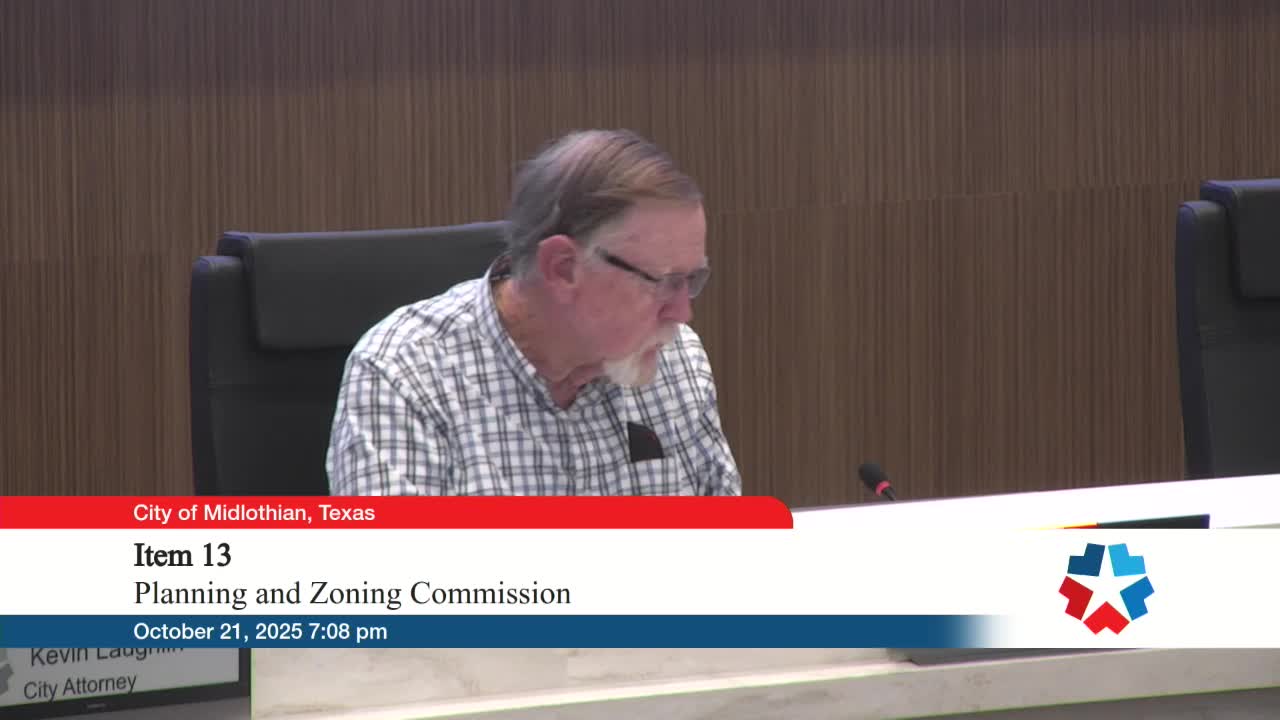Commission approves revisions to subdivision drainage design standards to tighten runoff and velocity limits
October 21, 2025 | Midlothian, Ellis County, Texas
This article was created by AI summarizing key points discussed. AI makes mistakes, so for full details and context, please refer to the video of the full meeting. Please report any errors so we can fix them. Report an error »

The Planning and Zoning Commission voted unanimously to recommend changes to the subdivision ordinance’s local drainage design standards. Staff described a package of amendments intended to improve stormwater management and reduce downstream erosion tied to recent development patterns.
Key changes presented by city engineering staff include:
- Clarifying use of hydrologic methods: the modified rational method remains standard for smaller basins, but the unit hydrograph method will be required above a 200‑acre threshold.
- Expanded runoff coefficient (C-value) table: the ordinance replaces a small set of broad coefficients with a more detailed table that better distinguishes lot sizes and surface types (staff said smaller lots and intensified development typically yield higher C-values).
- Updated IDF (intensity-duration-frequency) curves: staff provided region-specific IDF values for Ellis County to replace a generic curve table.
- Lowered allowable velocities for open channels and lined channels to reduce erosion risk (examples cited: grass-lined channels maximum lowered from 8 ft/s to 5 ft/s; concrete-lined channels from 15 ft/s to 12 ft/s; rock-lined channels lowered as well).
- Detention design and release targets: ponds will continue to be sized for 100‑year volume, but release rates for smaller design storms will be reduced (for example, the post-development discharge targeted for a 5‑year runoff will be held to the 2‑year pre‑development rate; similarly 10→5, 25→10, 50→25, and 100 stays at 100). Staff said the intent is to discharge less than pre-development flows for those smaller storms to mitigate downstream impacts and erosion.
Staff said the proposed amendments tighten standards rather than loosen them and that the changes will be incorporated into a future separate drainage design manual and stand-alone ordinance after additional work and public review. Commissioners discussed the limited time to review materials — staff had distributed the amendments the preceding Friday — but several commissioners said the approach is consistent with practices in other cities and aligns with the city’s desire to reduce post-development erosion and better protect downstream landowners. The commission approved the amendments 7–0.
Staff said applications already under review will proceed under the rules that governed their submissions; the ordinance changes will apply to new applications following adoption by City Council and after the subsequent administrative updates outlined by staff.
Key changes presented by city engineering staff include:
- Clarifying use of hydrologic methods: the modified rational method remains standard for smaller basins, but the unit hydrograph method will be required above a 200‑acre threshold.
- Expanded runoff coefficient (C-value) table: the ordinance replaces a small set of broad coefficients with a more detailed table that better distinguishes lot sizes and surface types (staff said smaller lots and intensified development typically yield higher C-values).
- Updated IDF (intensity-duration-frequency) curves: staff provided region-specific IDF values for Ellis County to replace a generic curve table.
- Lowered allowable velocities for open channels and lined channels to reduce erosion risk (examples cited: grass-lined channels maximum lowered from 8 ft/s to 5 ft/s; concrete-lined channels from 15 ft/s to 12 ft/s; rock-lined channels lowered as well).
- Detention design and release targets: ponds will continue to be sized for 100‑year volume, but release rates for smaller design storms will be reduced (for example, the post-development discharge targeted for a 5‑year runoff will be held to the 2‑year pre‑development rate; similarly 10→5, 25→10, 50→25, and 100 stays at 100). Staff said the intent is to discharge less than pre-development flows for those smaller storms to mitigate downstream impacts and erosion.
Staff said the proposed amendments tighten standards rather than loosen them and that the changes will be incorporated into a future separate drainage design manual and stand-alone ordinance after additional work and public review. Commissioners discussed the limited time to review materials — staff had distributed the amendments the preceding Friday — but several commissioners said the approach is consistent with practices in other cities and aligns with the city’s desire to reduce post-development erosion and better protect downstream landowners. The commission approved the amendments 7–0.
Staff said applications already under review will proceed under the rules that governed their submissions; the ordinance changes will apply to new applications following adoption by City Council and after the subsequent administrative updates outlined by staff.
Don't Miss a Word: See the Full Meeting!
Go beyond summaries. Unlock every video, transcript, and key insight with a Founder Membership.
✓
Get instant access to full meeting videos
✓
Search and clip any phrase from complete transcripts
✓
Receive AI-powered summaries & custom alerts
✓
Enjoy lifetime, unrestricted access to government data
30-day money-back guarantee

